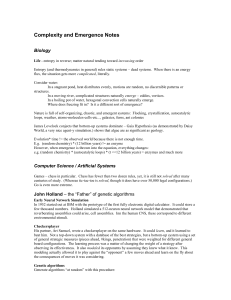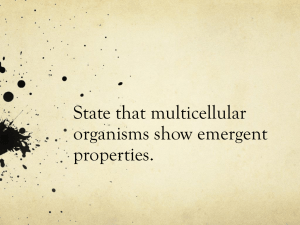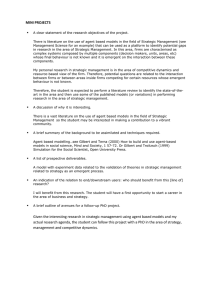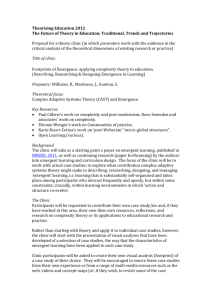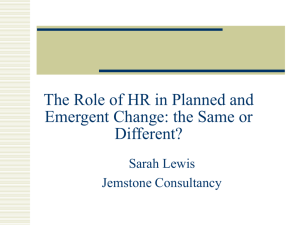Detecting Emergence in the Interplay of Networks John Symons , Jorge Louçã
advertisement
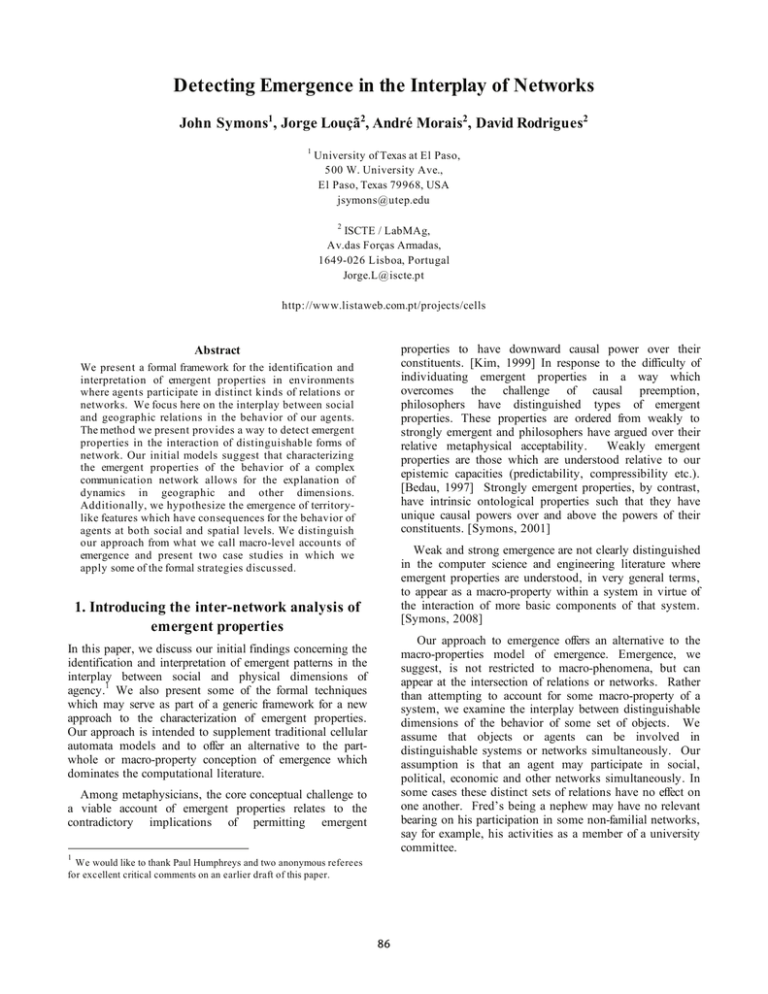
Detecting Emergence in the Interplay of Networks
John Symons1, Jorge Louçã2, André Morais2, David Rodrigues2
1
University of Texas at El Paso,
500 W. University Ave.,
El Paso, Texas 79968, USA
jsymons@utep.edu
2
ISCTE / LabMAg,
Av.das Forças Armadas,
1649-026 Lisboa, Portugal
Jorge.L@iscte.pt
http://www.listaweb.com.pt/projects/cells
properties to have downward causal power over their
constituents. [Kim, 1999] In response to the difficulty of
individuating emergent properties in a way which
overcomes the challenge of causal preemption,
philosophers have distinguished types of emergent
properties. These properties are ordered from weakly to
strongly emergent and philosophers have argued over their
relative metaphysical acceptability.
Weakly emergent
properties are those which are understood relative to our
epistemic capacities (predictability, compressibility etc.).
[Bedau, 1997] Strongly emergent properties, by contrast,
have intrinsic ontological properties such that they have
unique causal powers over and above the powers of their
constituents. [Symons, 2001]
Abstract
We present a formal framework for the identification and
interpretation of emergent properties in environments
where agents participate in distinct kinds of relations or
networks. We focus here on the interplay between social
and geographic relations in the behavior of our agents.
The method we present provides a way to detect emergent
properties in the interaction of distinguishable forms of
network. Our initial models suggest that characterizing
the emergent properties of the behavior of a complex
communication network allows for the explanation of
dynamics in geographic and other dimensions.
Additionally, we hypothesize the emergence of territorylike features which have consequences for the behavior of
agents at both social and spatial levels. We distinguish
our approach from what we call macro-level accounts of
emergence and present two case studies in which we
apply some of the formal strategies discussed.
Weak and strong emergence are not clearly distinguished
in the computer science and engineering literature where
emergent properties are understood, in very general terms,
to appear as a macro-property within a system in virtue of
the interaction of more basic components of that system.
[Symons, 2008]
1. Introducing the inter-network analysis of
emergent properties
Our approach to emergence offers an alternative to the
macro-properties model of emergence. Emergence, we
suggest, is not restricted to macro-phenomena, but can
appear at the intersection of relations or networks. Rather
than attempting to account for some macro-property of a
system, we examine the interplay between distinguishable
dimensions of the behavior of some set of objects. We
assume that objects or agents can be involved in
distinguishable systems or networks simultaneously. Our
assumption is that an agent may participate in social,
political, economic and other networks simultaneously. In
some cases these distinct sets of relations have no effect on
one another. Fred’s being a nephew may have no relevant
bearing on his participation in some non-familial networks,
say for example, his activities as a member of a university
committee.
In this paper, we discuss our initial findings concerning the
identification and interpretation of emergent patterns in the
interplay between social and physical dimensions of
1
agency. We also present some of the formal techniques
which may serve as part of a generic framework for a new
approach to the characterization of emergent properties.
Our approach is intended to supplement traditional cellular
automata models and to offer an alternative to the partwhole or macro-property conception of emergence which
dominates the computational literature.
Among metaphysicians, the core conceptual challenge to
a viable account of emergent properties relates to the
contradictory implications of permitting emergent
1
We would like to thank Paul Humphreys and two anonymous referees
for excellent critical comments on an earlier draft of this paper.
86
Alternatively, it may be that the influence from the
agents behavior in one network acts on its behavior in
another network in a uni-directional manner.
Let’s
assume, for instance that being a physical object can be
understood as being part of a network of objects governed
by physical laws. Most philosophers regard physical laws
as fundamental and maximally general. On the traditional
mereological view of part-whole relations, participation in
all other networks would supervene on the agent’s place
within the physical network. Belief in what philosophers
call strong supervenience is equivalent to the claim that the
agent’s place within a physical network fixes its place
within all other networks such that any object having the
same place in the physical network as some object a would
hold the same place in all networks as a. This would be
the case for most of the macro-properties under
consideration in traditional cellular automata models.
Macro-properties in these contexts do not act on their
constituents. Like properties supervening on their basal
physical properties, the patterns that are sometimes called
emergent in cellular automata models do not have the
power to modify their constituents. More precisely, as
modeled by traditional cellular automata, there is no way
to model such powers.
or communications networks are observed on geographical,
economic or other forms of network.
2. First steps in the application of the
approach: Cicada barbara lusitanica
Our first case study derived from experimental results
concerning live experiments on the stereotyped singing
response behaviors of cicadas. [Fonseca & Revez, 2002]
[Louçã et al., 2007] By observing the relationship between
constraints on communications networks and the resulting
geographical patterns in the movements of the cicadas, we
were able to conclude that insect songs encode specific
information about the identity of species, which are used
by individuals to discriminate conspecific from
heterospecific sympatric species.
In their empirical study of cicadas, Fonseca and Revez
argued that both the frequency spectrum of the male
cicadas’ signal and its temporal pattern carries information
about the species-identity of the singer. By modeling the
interplay between alternative types of song patterns and
their resulting georgraphical patterns we provide further
support to the empirical findings of Fonseca and Revez,
showing why the use of only one parameter in the cicada
song is suboptimal.
Our view is that the mereological approach to emergence
fails to capture some important features of the natural world
and that it is especially inadequate in the social sciences.
An agent can be a member of a distinct set of networks
governed by a variety of different rules, and in some
contexts, by virtue of being involved in these distinct
networks, agents can occasionally serve as the site for
productive interplay between networks. In this interplay,
we claim that one can sometimes find emergent properties.
These properties are not always best characterized as
macro-properties of one system in particular.
The pre-copulatory isolating mechanism based on song
analysis, used to maintain species integrity, uses one
or/and another parameter according to the species
environment. In our simulations, we compare the input
communication patterns, based on frequency spectrum or
time pulse, and resulting emergent movement patterns in a
community of insects. Sample results from our model of
the geographical movement of the cicadas are depicted in
Figures 1 and 2.
While we regard our approach as having general
applicability to interactions between networks, at present,
our research is focused on the interplay between social
communication networks and geographical location.
Specifically, we are interested in the reciprocal relations
between an agent’s social/communication networks and its
spatial location. We have modeled these relations in our
case studies on cicada mating behavior and human smart
mobs. [Louçã et al., 2007] While there is an obvious
“bottom-up” effect from spatial relationships to
communicative relationships, our working hypothesis is
that social factors can have a causal effect on the spatial
locations of agents. What we mean by social factors here
is left deliberately non-specific. In our study of cicada
behavior for instance, the factors we considered were related
to species-specific constraints on the communications
network. We studied the relationship between the species
movement in geographical space and alternative sets of
constraints on the cicadas’ communication systems.
However, a range of alternative applications can be
explored wherein the effects of varying constraints on social
Figure 1: The Cicada Barbara lusitanica model: trails of
cicadas considering no input patterns.
87
3. Social networks and their spatial
dynamics: Smart Mobs
In our model, cicadas use song recognition patterns, to
guide their motion towards males through the
environment. Their motion exhibits a structure depending
on the system of recognition in use. The movement of
cicadas covers the space with clear tracks. As we can see in
figure 2, the particular case of simultaneously using both
recognition patterns results in a thin network, with more
tracks and more rapid access to males of the corresponding
species (image on the right). On the other hand, when there
is no use of recognition patterns, dislocations are short and
their direction is random, with no clear existence of tracks
(figure 1). We can also model alternative strategies for
pattern recognition in cicadas in order to exhibit their
macro features.
Howard Rheingold introduced the expression “smart
mob” to describe the concept of a “mobile ad hoc social
network”. [Rheingold, 2002] Smart mobs are social
networks where people communicate using mobile and
wireless internet technologies. Smart mobs are becoming
increasingly familiar for their role in social and political
expression. For example, SMS communication was used
to organize mass protests all over Spain in the aftermath of
the Madrid train bombings of March 11th 2004. Viral
communication strongly spread through social networks
mainly composed of friends, where trust between members
of the network is extremely high.
We have designed a generic model of smart mob
dynamics, where the viral propagation of communication
through the social networks of individuals coexists with
the coordinated movements of individuals to some meeting
point. Our model of smart mobs comprises two types of
agents, individuals and attractors. Very briefly, when an
individual finds an attractor, he propagates this information
to all his friends; consequently, they will then move
towards the attractor.
Some results of the simulation
can be observed in the following images:
Figure 2: The Cicada Barbara lusitanica model: trails of
cicadas considering both time and frequency patterns.
These results illustrate the interplay between spatial
location, usage of energy and the features of social or
communications network in cicadas behavior. This
interplay is, of course directly related to the preservation of
their species. This is a very simple model which relates
constraints at the level of the communication network with
movement through space. Our next model involves a
2
slightly more complex social network.
Figure 3: The Smart Mobs model: showing a sample of a
communication network
2
Figure 3 represents communications between individuals
in a social network. In this portion of the social network
two individuals are acting as attractors. By contrast, figure
4 (below) depicts the physical movement of the
individuals. Our experiments showed that the trace of the
movement of the individuals through physical space
Supporting documentation and simulations for both the cicadas and
the smart mobs models can be found at:
http://www.listaweb.com.pt/projects/cells
88
indicates
geographic
characteristics
of
specific
configurations of the social network in its interplay with
some physical constraints.
Our goal is to develop techniques which permit us to
relate patterns from distinct networks and to model the
appearance of new features which emerge from their
interaction. An operational goal of this research is to
provide a generic framework (a set of tools composed by a
methodology, algorithms and a programming library) for
the analysis of networks and for the identification of
emergent properties or fingerprints. The framework aims at
providing formal characterization of the following main
notions:
•
communication network – a set of nodes and
links, excluding the semantics of communication
acts.
Communication networks can be very
broadly construed to include a wide variety of
dynamic systems of rule governed relations
between agents;
•
emergent fingerprint within a communication
network or at the intersection between systems.
We leave the notion of emergent fingerprint
deliberately vague.
We simply mean, the
appearance of a pattern in the system which has
salient and stable features such that it can play a
role in the causal economy of the set of objects
under consideration.
We have been using the
intuitively accessible notion of territory in our
exposition, but one important role of our approach
would be the discovery of previously undetected
emergent properties;
•
algorithms to identify emergent fingerprints in a
communication network model. These algorithms
may be based, for example, on the frequency paths
of communication flow in a simulation after n
iterations.
Figure 4: The Smart Mobs model: The same two attractor
sample, showing the territorial movements of individual s
towards the two attractors.
In future work we will apply the methodology described
above to the analysis of community relations and
territoriality in smart mobs models.
The tools we
developed in the smart mob and cicada models form the
basis for the inter-network analysis of emergence described
here.
The Z language [Spivey, 2006] is used to formally
characterize the approach. This specification language
allows, on the one hand, the formalization of a set of
concepts and the relations between those concepts, and on
the other hand the possibility of straightforwardly
converting the formal model into programming code.
4. Formalizing the interplay
Our case studies provide some insight into the manner in
which collective behavior of the system in geographical
space is shaped by constraints on communication. The
next step is to provide a general formal framework for
detecting emergence between networks.
We formalize the following major steps within the
framework: the pattern detection mechanism applied to
social networks (ComNet); the pattern detection
mechanism applied to cellular automata (GeoNet); and the
identification of links between patterns that were detected at
different levels.
In our research, we have focused on formalizing the
process of identifying emergent properties which result
from the interaction of communications networks and
geographical movement. In more concrete terms, by
associating patterns in different kinds of system we hope to
connect the notions of place, movement and territory to
social relationships represented in social networks. To this
end, we develop hybrid models which combine multiagent social simulation, cellular automata and social
network analysis. This allows us to propose a way of
representing the effects of social relations or communication
on physical location.
From here, we plan to track the properties of these links,
sifting through them in order to determine whether they
constitute a causally or at least an explanatorily relevant
system of their own. For example, the notion of territory
results from the interplay of social networks and
geographical space. However, territories play a role in
modifying both geographical and social relationships. In
this sense, territories have causal consequences in the
structure of both networks.
89
By formalizing the process of discovering links between
patterns at distinct levels, we hope to provide a general
approach to the identification of previously unrecognized
emergent phenomena. While in the models discussed
above, the cellular automata are our way of representing the
spatial or geographical dynamics of the agents in question,
alternative interpretations of what it is that the cellular
automata are representing could be introduced.
The
interpretation of the dynamics of the cellular automaton
will be dependent on what it is that the researcher is
attempting to model.
A variety of systems of relations can be characterized as
communications networks and our approach is intended to
be as generally applicable as possible.
ComNet. The pattern detection mechanism applied to
social networks follows the detection of the group in a
topological space. This strategy was initially proposed by
Feldman et al. [2007] and was developed by Morais.
[2007]
Figure 6: Formal representation of the function isolating
communities
These algorithms serve to process the data produced
initially by the cellular automata in order to establish the
character of the social network. From this network we
isolate communities by analyzing the network of relations.
We start by quantifying the degrees of relationships
between neighbors for each node in the network and from
there we find the node with maximum degree of
connectivity. This node and all the nodes directly
connected to it will belong to one community. Afterwards
all connections to this node are removed. This procedure is
continued until there are no connections left in the
network.
Figure 5: Formal representation of the function detecting the
node of maximal degree
Figures 5 and 6 present the formal description of the
algorithms isolating communities in a social network.
Figure 7: Formal representation of the function detecting
social structures
This is a relatively simple strategy for determining
distinct communities within social networks. Based on the
previously determined community structure we find the
pair of communities that could be merged to increase the
90
overall modularity of the network (see Figure 7). This is
determined by calculating the value for Phi, meaning the
modularity change resulting from such merger. This
procedure is carried until no such pair exists. The result is
a group of sub-networks, representing communities.
Figure 9: Formal representation of the function eliminating
irrelevant values
The resulting communities which our analysis extracts
demonstrate that there exists a previously unrecognized
level of organization in the data. We begin from data that
is organized merely by the structure of respective
interconnections. These interconnections are derived from
the modeled behavior and, therefore, the organization of
elements in sub-networks is a property of a macro-level.
From the normalized data, a threshold is defined to
eliminate irrelevant values that arise in the data set. This
allows the selection of the strongest features present.
The fact that elements within these sub-networks or
communities have more connections to one another than to
elements that are not in the same group is, in part random
and in part a result of additional constraints, including, in
some of our models a set of general physical or spatial
constraints on the formation of new friendships.
Constraints at the level of spatial relations led us to
consider the interplay between the communicative and
geographical constraints that act on social agents.
Figure 10: Formal representation of the function reconnecting
selected nodes
To characterize the territories of sub-groups, we can map
our social or communication networks to the physical
location of the agents, thus determining whether some
group behavior exists that may be characterized as
governed or influenced by the existence of a specific
territory. In this sense GeoNet is an essential part of this
project since it allows us to build social networks from the
spatial patterns of specific models.
In the normalized and selected data determined
previously, we define the nodes and connections so that
this data may be analyzed as a network.
To these networks generated by the GeoNet algorithm
we can now apply the ComNet algorithms to try to identify
the communities that where formed. In this way, we can
map the communities to the territories occupied by each of
them in the cellular automaton space.
GeoNet. The concept of pattern detection in cellular
automata targets what we call ‘fingerprints’ in a set of
tracks left by agents as they move through some defined
spatial region. We propose to convert the spatial pattern of
these fingerprints to a social network in order to apply
social network metrics. To do this, we define the GeoNet
mechanism to map a geometrical model to a topological
one.
This allows us to validate the ComNet algorithm as a
process of identifying communities since in our
experimentation we are privy to knowing which
community an agent belongs ahead of time. In the
construction of the model this process is repeated to find
the optimal parameters for the GeoNet algorithm that will
then be used to create the relations between the patterns
observed from GeoNet and ComNet.
Relating Patterns. Finally, patterns derived from
ComNet and GeoNet can be associated to relate patterns
characterizing different levels of analysis.
The dynamics of each simulation is analyzed by
determining the number of times each pair of structure and
trail map occurs. We start by combining all possible
tuples of specific trail maps and structures. Then we count
how many times each tuple occurred. This allows us to
infer a causal effect between the two levels of analysis.
Figure 8: Formal representation of the function normalizing
trails
From the trails left by agents in geometrical space the
first step involves the normalization of data, represented in
Figure 8, to allow comparison between different data sets.
91
Our approach extends Holland’s work insofar as it is not
restricted to the analysis of a single system and its
macroproperties. Instead, we consider a set of agents
participating in a number of distinct systems or networks
simultaneously. For example, an agent can be considered
as part of a communications or social network and as a
location in a geographical space. We have described how it
is possible to link distinct networks and track novel
features that appear at the intersection.
By way of an example of the kind of emergent property
that we believe has an inter-network nature, we suggested
that the interplay between social network dynamics and
physical locations gives rise to the notion of territory.
Consider the properties of a territory. One can regard
territories as emergent properties which result from and in
turn modify the spatial and social relations governing an
agent. The strength of some social relations will be
weakened or reinforced by territories while territories also
have some role in modifying the probability of some
physical movements of agents.
Figure 11: Formal representation of the function relating trail
and social structure patterns
Simulations where there is a salient effect
between the two levels of analyses will present a larger
number of occurrences when compared to pure random
simulations.
The process of finding territories and tracking their
effects on the social and geographical networks is a nontrivial technical challenge. We have begun to show how it
might be achieved in the previous section. However,
given the difficulty of the project, it is worth contrasting
the approach to the limitations of traditional cellular
automata models in order to motivate researchers to
consider our approach.
It could be argued that this result is obvious as it
arises from the rules of the model. Although the rules are
programmed, they aren’t used to predict or to map the
results and are used only for the training of the algorithms.
After that they are forgotten and the analysis is directed
solely towards patterns at the network and trail levels.
The methodology formally depicted above was
developed out of a series of case studies [Louçã et al.,
2007; Rodrigues, 2007; Morais, 2007] wherein we
developed the representation of geometrical patterns and the
relationship of geometrical patterns to topological patterns.
As we have discussed above, Holland and others treat
emergence as a feature of a single system of agents and
states and thus the formal representation of emergence
involves specification of the possible mappings between
the states of that system. These mappings can be captured
via a transition function which maps the set of possible
states of a system onto itself. Holland describes the
characterization of the transition function along the
following lines:
5. Contrasting macro-property and internetwork analyses of emergent properties
Classic cellular automata models of emergence, like
John Holland’s for example, are meant to provide formal
accounts of the appearance of macro-level patterns of
collective behaviour within a particular system. Macroproperties appear from the interaction of rules governing the
basic constituents of a system. As such, Holland regards
emergence as “the obverse of reduction”. [1997, 38] This
is what philosophers would call a mereological or partwhole conception of emergence.
The set of states S {s1, s2, s3, …} is taken to be finite
for the sake of computational tractability. A transition
function takes as its argument some state of the system in
combination with some input at a time and gives as a
value a state of the system. For any input of type j there
will be an associated set of possible input values Ij.
Holland’s purpose in tracking the behaviour of cellular
automata is to observe how the interactions of constituent
level phenomena can give rise to emergent properties at the
macro-level. He shows how critical these interactions are
in the appearance of macro-properties of a system and he
regards them as eluding a scientific study of the
constituents in isolation; “A detailed knowledge of the
repertoire of an individual ant does not prepare us for the
remarkable flexibility of the ant colony.” [Holland 1998,
130]
where ij2 names state number 2 of the input j. Given k
types of input for the system there will be k sets of possible
input values
Thus,
Ij = {ij1, ij 2, ij 3, …}
{I1, I 2, I 3, …Ik}.
The set of all combinations for the system is given as the
product of the sets
I1I 2I 3 …Ik .
92
Now, the transition function can be defined as
f: (I1I 2I 3 …Ik ) S
macro-properties approach which has dominated traditional
cellular automata accounts of emergence.
S
and the temporal dynamic of the system can be defined as
References
S(t+1) = f(I1(t), I 2(t), I 3(t), …Ik(t), S(t)).
Bedau, M. 1997. Weak Emergence Noûs, Vol. 31,
Supplement: Philosophical Perspectives, 11, Mind,
Causation, and World 375-399.
The iteration of f generates the state trajectory of the
system. [Holland 1998, 130-131] Thus, the core
methodological assumption in traditional cellular automata
approaches to emergence is the idea of functions mapping
the set of states of a system onto itself. By contrast, our
approach involves a single set of objects which are seen as
participating in two distinct networks or systems of
relationships. The emergent features which we hope to
understand and detect cannot be characterized in the manner
described by Holland. In part, this is because what we are
calling the emergent properties will (in Holland’s terms)
modify the transition functions acting on the initial
specification of the possible states of the system in each of
the interacting levels in a way that is not dependent on the
rules governing that initial specification of states. For
instance, in the example mentioned previously, we
hypothesize that the transition functions which act on the
set of possible states in the social network will not
accurately capture the temporal dynamic of the system once
one takes account of the interaction with the agents’
geographical location. This is simply because, the social
dynamic in which an agent participates will be the subject
to the effects of emergent territorial properties.
In
addition, territories will play a role in the physical location
of an agent in a specific social network.
Du, H., Feldman, M, Li S., Jin, X. 2007. An Algorithm
for Detecting Community Structure of Social Networks
Based on Prior Knowledge and Modularity. Complexity
vol. 12 nr. 3, pp. 53-60.
Fonseca, P. J., Revez, M. A. 2002. Song discrimination
by male Cicada barbara lusitanica (Homoptera, Cicadidae).
The Journal of Experimental Biology No.205, 1285-1292,
Ed. The Company of Biologists Limited, U.K.
Holland, J. 1997. Emergence: From Chaos to Order.
Redwood City, CA: Addison-Wesley
Kim, J. 1999. Making Sense of Emergence Philosophical
Studies 95: 3–36,
Louçã, J., Symons, J., Rodrigues, D., Morais, A. 2007.
Pattern-oriented analysis of communication flow: the case
study of Cicada barbara lusitanica. 21st European
Conference on Modelling and Simulation - ECMS 2007,
Prague, Czech Republic.
Morais, A. 2007. Growing a dubious network and
detecting terrorist groups. Report - Master program in
Complexity Sciences (ISCTE/FCUL, Lisbon).
6. Conclusion
Traditional cellular automata models illustrate the idea
that the interaction of transition functions may give rise to
behaviours that are not captured by the transition functions
in isolation. This is an important insight which our
approach preserves. As described in the previous section,
emergence via constrained generating procedures is such
that given a deterministic system governed by more than
one kind of rule ranging over the behaviour of a simple set
of elements we can often find a contingent set of initial
conditions such that some a macro-property is generated by
the system in question. Such models resolve puzzles
concerning how it is that specific macro-properties might
have come into being by modelling the interaction of
transition functions given some specific set of initial
conditions.
Rheingold, H. 2002. Smart Mobs: the next social
revolution. Basic Books.
Rodrigues, D. 2007. CellCom - A Hybrid Cellular
Automaton Model of Tumorous Tissue Formation and
Growth. Report - Master program in Complexity Sciences
(ISCTE/FCUL, Lisbon).
Spivey, J. M. 2006. The Z Notation: a reference manual,
Prentice Hall.
Symons, J. 2001. Emergence and Reflexive Downward
Causation. Principia – An International Journal of
Epistemology. 6, 14-39, 2002
Our approach extends traditional cellular automata
accounts of emergence insofar as we aim to study the
appearance of emergent properties in contexts where agents
are governed by different systems of interacting relations.
In our initial modelling projects, we highlight the
interplay between social and spatial relations. The broader
purpose of this work is to suggest new approaches to the
study of emergence and to present an alternative to the
Symons, J. [forthcoming]. Computational models of
emergent properties. Minds and Machines. Preprint
available
at:
[http://www.johnfsymons.com/Computational%20Models
%20of%20Emergent%20Properties.pdf]
93
